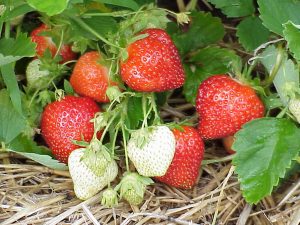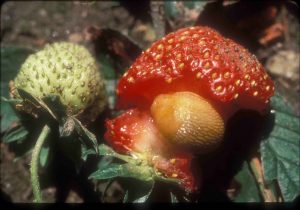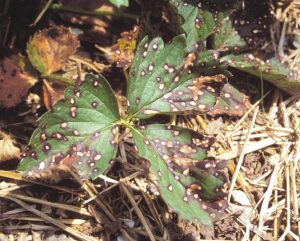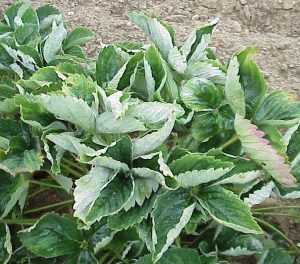Strawberry IPM Newsletter No. 3 – June 7, 2019

Strawberry IPM Newsletter No. 3 – June 7, 2019
Click on photos to enlarge.
BLOOM STILL UNDERWAY; GRAY MOLD CONCERNS
Two-Spotted Spider Mites High in Some Fields
Situation:
Not a lot of change in the situation since last week; cool damp weather predominates most of the state, slowing strawberry bloom and fruit development. Early fields in southern Maine are at petal fall, although some rows that were under row covers may be ready for harvest late next week. Northern growers are reporting more winter injury, and deer injury.
Strawberry bud weevil or “clipper”: Activity was fairly low in fields that we’ve scouted this week. Only three fields, in Dresden, Lewiston and Monmouth, were over the threshold of more than 1 clipped bud per two feet of row of live clippers visible. Some fields in southern Maine have most of the flower buds open now, so clipper should no longer be a significant concern there; but later fields with flower buds still emerging should be scouted for clippers regularly. We expect clipper damage to increase as temperatures warm. Clippers will also attack the buds of raspberries and blackberries, although they do not usually cause significant injury.
Tarnished plant bug activity continues to be very low this week. Early instar nymphs were found in Wells and Limington, but not yet at threshold levels. With warmer temperatures, nymphs could appear very quickly, so it is important to scout for them regularly and apply controls if more than 4 flower clusters out of 30 sampled are infested.

Two-spotted spider mites: Despite recent weather that has not been conducive to spider mite infestations, we have found mites in some fields this week, including fields in Wayne and Bowdoinham that were over the 25% infestation control threshold. Other fields around the state also had mites, but at levels well below the threshold. Mite populations can flair up quickly under hot dry conditions, so it is important to scout for them regularly. If 25% of leaves sampled (e.g. 15 out of 60) have any mites, a spray should be applied.

Slugs may be a problem this season. Moist conditions and mulch encourage the presence of these mollusks. Slugs usually feed at night, leaving large holes in the leaves and tunnels in the ripening fruit. Baits such as Deadline® and Sluggo® offer some control, but should be used prior to fruit ripening. Pay close attention to label instructions and precautions. Baits should also be applied to the fields in mid-September if slugs have been a problem, to reduce egg-laying for next year’s generation.
Diseases: As more fields come into bloom, protection of the flowers against infection by gray mold is critical. Two to three sprays of fungicide during bloom are typically required to provide good protection, especially under the wet conditions that have prevailed this spring. Additional applications may be applied if there is significant rainfall between sprays. Remember to alternate chemical fungicide families when spraying for gray mold to prevent the development of resistance.
Leaf spot has been seen in most fields this week, usually on the lower, older foliage. Purple spots on the leaves with white centers characterize the symptoms. Younger foliage may become infected and cause the plants to weaken, if left untreated. Fungicides applied to manage gray mold may also provide control of leaf spot. Captan, Luna Sensation®, Mervion® and Pristine® have activity on both diseases.
- Leaf Spot, photo by David Handley
- Powdery Mildew, photo by David Handley
Powdery mildew: Some early symptoms of powdery mildew were noticed in one field this week, with upward cupping of the leaves and reddish streaking on the leaf and flower stems. This disease is likely to become more prevalent as temperatures warm up. Consider using a fungicide that will control powdery mildew, such as captan + Topsin-M®, or Pristine® when you’re spraying for gray mold.
Spring Fertilizers: With all of the rain this spring, growers may be concerned about fertility levels in the soil. Typically, we recommend being conservative with nitrogen applications in the spring to avoid promoting excessive vegetative growth, soft fruit and encouraging gray mold. Depending upon soil type and history, only 15 to 30 lb. of actual nitrogen per acre is adequate to promote good early growth. However, if your soils are light and prone to leaching, early nitrogen applications may not have been taken up by the plants. Plants that have yellow or reddish color and short petioles (leaf stems) may benefit from a light nitrogen application. If you have already applied nitrogen this spring, keep the supplemental rate low (10-20 lb.). If you haven’t applied nitrogen, a heavier application may be more effective (20-30 lb.). Calcium nitrate (15.5% Ca) is a good source of available nitrogen and also supplies calcium, which can be helpful in fruit development. Boron applications in the spring can also be helpful in promoting good pollination and early fruit development. However, boron in high amounts can be toxic to the plants. One to two pounds of actual boron per acre is usually adequate to meet the needs of strawberry plants, often applied as a foliar spray of Solubor (20% B).
The 2019-2020 edition of the New England Small Fruit Management Guide is now available.
If you would like to purchase a copy please contact Pam St. Peter at pamela.stpeter@maine.edu or the Highmoor Farm address below. Copies are $15 each. You can also access the guide on the UMass Cooperative Extension website.
Sincerely,
David T. Handley
Vegetable and Small Fruit Specialist
Highmoor Farm UMaine Extension Diagnostic
P.O. Box 179 Research Lab, Pest Mgmt. Unit
52 U.S. Route 202 17 Godfrey Drive
Monmouth, ME 04259 Orono, ME 04473
207.933.2100 1.800.287.0279
The University of Maine is an equal opportunity/ affirmative action institution.
Where brand names or company names are used, it is for the reader’s information. No endorsement is implied nor is any discrimination intended against other products with similar ingredients. Always consult product labels for rates, application instructions and safety precautions. Users of these products assume all associated risks.


